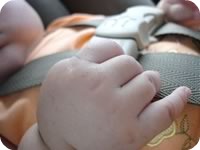
New advice released March 21st, 2011 from the American Academy of Pediatrics (AAP) will change the way many parents buckle up their children for a drive.
In a new policy published in the April 2011 issue of Pediatrics (published online March 21), the AAP advises parents to keep their toddlers in rear-facing car seats until age 2, or until they reach the maximum height and weight for their seat. It also advises that most children will need to ride in a belt-positioning booster seat until they have reached 4 feet 9 inches tall and are between 8 and 12 years of age.
The previous policy, from 2002, advised that it is safest for infants and toddlers to ride rear-facing up to the limits of the car seat, but it also cited age 12 months and 20 pounds as a minimum. As a result, many parents turned the seat to face the front of the car when their child celebrated his or her first birthday.
“Parents often look forward to transitioning from one stage to the next, but these transitions should generally be delayed until they’re necessary, when the child fully outgrows the limits for his or her current stage,” said Dennis Durbin, MD, FAAP, lead author of the policy statement and accompanying technical report.
“A rear-facing child safety seat does a better job of supporting the head, neck and spine of infants and toddlers in a crash, because it distributes the force of the collision over the entire body,” Dr. Durbin said. “For larger children, a forward-facing seat with a harness is safer than a booster, and a belt-positioning booster seat provides better protection than a seat belt alone until the seat belt fits correctly.”
While the rate of deaths in motor vehicle crashes in children under age 16 has decreased substantially – dropping 45 percent between 1997 and 2009 – it is still the leading cause of death for children ages 4 and older. Counting children and teens up to age 21, there are more than 5,000 deaths each year. Fatalities are just the tip of the iceberg; for every fatality, roughly 18 children are hospitalized and more than 400 are injured seriously enough to require medical treatment.
New research has found children are safer in rear-facing car seats. A 2007 study in the journal Injury Prevention showed that children under age 2 are 75 percent less likely to die or be severely injured in a crash if they are riding rear-facing.
“The ‘age 2’ recommendation is not a deadline, but rather a guideline to help parents decide when to make the transition,” Dr. Durbin said. “Smaller children will benefit from remaining rear-facing longer, while other children may reach the maximum height or weight before 2 years of age.”
Children should transition from a rear-facing seat to a forward-facing seat with a harness, until they reach the maximum weight or height for that seat. Then a booster will make sure the vehicle’s lap-and-shoulder belt fit properly. The shoulder belt should lie across the middle of the chest and shoulder, not near the neck or face. The lap belt should fit low and snug on the hips and upper thighs, not across the belly. Most children will need a booster seat until they have reached 4 feet 9 inches tall and are between 8 and 12 years old.
Children should ride in the rear of a vehicle until they are 13 years old.
Although the Federal Aviation Administration permits children under age 2 to ride on an adult’s lap on an airplane, they are best protected by riding in an age- and size-appropriate restraint.
“Children should ride properly restrained on every trip in every type of transportation, on the road or in the air,” Dr. Durbin said.
The American Academy of Pediatrics is an organization of 60,000 primary care pediatricians, pediatric medical subspecialists and pediatric surgical specialists dedicated to the health, safety and well being of infants, children, adolescents and young adults. Read the full press release here.
Your thoughts..
What do you think about this new advice from the American Academy of Pediatrics? Will you keep your baby in the rear facing position until he/she is two years old? Why? Why not?
With my oldest, who turns 3 next month, I had to move her to a convertible car seat at 9 months and kept it rear facing until a year at which point her legs were very scrunched up because she is a very tall child(they don’t have a percentage for her even they just put above 97%). My youngest daughter who is just over 16 months old is still in her rear facing infant seat though. She was a preemie so she is very very small. I plan on keeping her in her baby seat until she out grows it and then in a convertible seat rear facing until she gets too tall for it.
I vividly remember being about 6 years old and getting out of my booster seat and thinking it was stupid my cousins had to use them until age 8 and now up to age 12?!?! I’m sorry but when I was 12 I was in 7th grade…there was no way I was going to ride in a booster seat. And who wants to go spend the night at a friends house and have to bring their booster seat because they are shorter? I have 2 friends I finished high school with who are shorter than that to this day. I understand safety and all but when will they draw the line? And if all this is such an issue why don’t school buses even have seat belts at all?